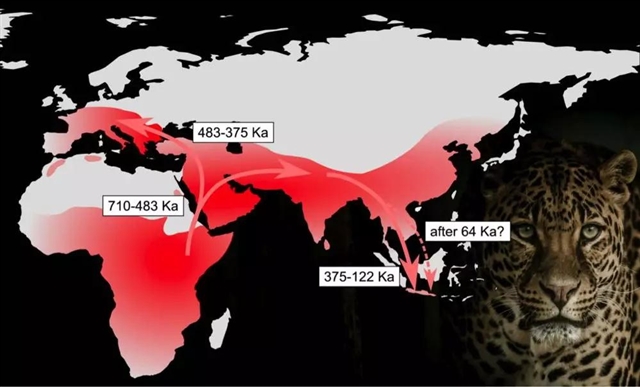|
|
|
|
|
走出非洲的豹,没能在欧洲走下去 | BMC Evolutionary Biology |
|
|
论文标题:Historical biogeography of the leopard (Panthera pardus) and its extinct Eurasian populations
期刊:BMC Evolutionary Biology
作者:Johanna L. A. Paijmans, Axel Barlow, Daniel W. Förster, Kirstin Henneberger, Matthias Meyer, Birgit Nickel, Doris Nagel, Rasmus Worsøe Havmøller, Gennady F. Baryshnikov, Ulrich Joger, Wilfried Rosendahl and Michael Hofreiter
发表时间:2018/10/23
数字识别码:10.1186/s12862-018-1268-0
原文链接:https://bmcevolbiol.biomedcentral.com/articles/10.1186/s12862-018-1268-0?utm_source=other&utm_medium=other&utm_content=null&utm_campaign=BSCN_2_WX_BMCEvolBio_Arti_Scinet
微信链接:https://mp.weixin.qq.com/s/m0iQnlkSkwrtVoVFXMNVcw
了解豹种群的地理起源是一项复杂的工程。人们从分子学数据所推断出的演化模式和已有的化石证据并不一致。最近在BMC Evolutionary Biology上发表的一项新研究寻访了历史悠久的豹线粒体DNA样本,以期更进一步了解远古和现代豹种群的演化历史。在接下来的文章中,Johanna Paijmans博士向我们介绍了她和同事们进行的这项研究。

豹虽然无法改变自己身上的斑纹,但可以移动自己的踪迹在地图上留下的斑点。
豹(Panthera pardus)是典型的大型猎食性动物,目前主要分布在非洲和亚洲大部分地区。通常认为亚洲豹是非洲豹的后代,这种迁移主要发生在生物向非洲以外的地区扩散的事件中(和我们人类的演化历史一样)。
我们从化石遗迹中了解到,在更新世(Pleistocen)的大部分时期中,欧洲也存在豹,但是这些欧洲豹在末次冰期(约25000年前)中不幸灭绝了。这些已灭绝的欧洲豹与现存的非洲豹和亚洲豹的关系至今仍是个谜。
我们研究了来自欧洲“冰河时代”古老的豹DNA样本(有些已经存在了45000年),以及来自博物馆藏品的亚洲豹和非洲豹样本,以期弄清有关远古豹和现代豹之间的关系以及这些典型猎食者的生物地理学特征。
生物地理学会对被研究对象世系的地理分布进行分析,并推断出可能导致现存模式的过去事件。例如,到最后一个冰川期结束为止,豹一直生活在欧洲,这些灭绝种群的DNA可以让我们了解它们的起源,以及它们与现存豹的关系。
对当前种群DNA的研究可能只能揭示存活下来的豹的遗传多样性。而罕见的来自远古和历史样本的DNA,可以让我们从独特的角度了解物种的演化历史和遗传多样性。通过它,我们能够获得已消失的种系和种群(如欧洲豹)的相关信息。
我们对远古DNA的序列分析发现,与非洲豹相比,亚洲豹的祖先与欧洲豹才更亲近。这表明,欧洲豹的种群是在形成亚洲豹种群的向非洲以外的地区迁移的同一过程中形成的。

在历史和远古DNA的线粒体基因组基础上建立的豹的历史生物地理学分布
走出非洲:不是第一步,也不是最后一步
我们的数据进一步表明,有关所有现存豹的非洲血统假说是正确的。除此之外,还有许多其他哺乳动物也被认为具有非洲血统(例如鬣狗,狮子),其中也包括我们的祖先。
我们使用了化石校准的遗传方法来估算豹向非洲以外的地区迁移的时间,结果发现这个时间大约是在71-48.3万年前。豹的遗传数据也表明,向非洲以外的地区迁移是一个单次事件,并不是多次重复的事件。
这一事件的发生时间与最早的原始人类(大约2百万年前的直立猿人,Homo erectus)或最早的解剖学意义上的现代人(大约10万年前的智人,H. sapiens)的扩散没有直接相关关系,所以很可能存在不同的过程推动了不同物种向非洲以外的地区扩散。
来自爪哇豹的意外发现

图片来自:Karla Fritze,德国波茨坦大学
我们的豹样本中有一个来自爪哇,这种来自爪哇的豹被单独分为一个亚种(爪哇豹,Panthera pardus melas)。过去有研究发现,爪哇豹的DNA与所有大陆亚洲豹的DNA都不同,这表明这个种群在东南亚已经分离了很长一段时间。然而,我们发现爪哇豹的博物馆标本与印度支那豹(Indochinese leopard)密切相关,这表明大陆豹和爪哇豹之间可能在近期发生过遗传交换。
虽然我们应当对单个样本的结果持谨慎态度,但是这些结果确实表明有必要对爪哇豹及其与大陆种群的关系进行更详细的研究。
对现代豹研究的启示
我们研究了线粒体DNA,它仅仅只是基因组的一小部分,并且只能通过雌性系继承。因此,线粒体DNA只能揭示物种演化历史的一部分,并且可能有多种情景导致相似的遗传模式,使得其难以区分。
来自爪哇豹的意外发现便反映了在保护策略制定方面存在的问题。目前,对爪哇豹的保护工作是在认为其是独特亚种的分类基础上进行的。我们的研究结果提示大陆豹和爪哇豹之间发生过基因流动,并且发生的时间比过去认为的更近,这可能会对豹种群的管理产生影响。
然而,目前的分类学除线粒体DNA之外,还会考虑了许多其他因素。未来需要收集更多的数据来充分表征爪哇豹与大陆豹之间的关系,以及如何以最好的方式确保它们能持续生存。
摘要:
Background
Resolving the historical biogeography of the leopard (Panthera pardus) is a complex issue, because patterns inferred from fossils and from molecular data lack congruence. Fossil evidence supports an African origin, and suggests that leopards were already present in Eurasia during the Early Pleistocene. Analysis of DNA sequences however, suggests a more recent, Middle Pleistocene shared ancestry of Asian and African leopards. These contrasting patterns led researchers to propose a two-stage hypothesis of leopard dispersal out of Africa: an initial Early Pleistocene colonisation of Asia and a subsequent replacement by a second colonisation wave during the Middle Pleistocene. The status of Late Pleistocene European leopards within this scenario is unclear: were these populations remnants of the first dispersal, or do the last surviving European leopards share more recent ancestry with their African counterparts?
Results
In this study, we generate and analyse mitogenome sequences from historical samples that span the entire modern leopard distribution, as well as from Late Pleistocene remains. We find a deep bifurcation between African and Eurasian mitochondrial lineages (~ 710 Ka), with the European ancient samples as sister to all Asian lineages (~ 483 Ka). The modern and historical mainland Asian lineages share a relatively recent common ancestor (~ 122 Ka), and we find one Javan sample nested within these.
Conclusions
The phylogenetic placement of the ancient European leopard as sister group to Asian leopards suggests that these populations originate from the same out-of-Africa dispersal which founded the Asian lineages. The coalescence time found for the mitochondrial lineages aligns well with the earliest undisputed fossils in Eurasia, and thus encourages a re-evaluation of the identification of the much older putative leopard fossils from the region. The relatively recent ancestry of all mainland Asian leopard lineages suggests that these populations underwent a severe population bottleneck during the Pleistocene. Finally, although only based on a single sample, the unexpected phylogenetic placement of the Javan leopard could be interpreted as evidence for exchange of mitochondrial lineages between Java and mainland Asia, calling for further investigation into the evolutionary history of this subspecies.
阅读论文全文请访问:
https://bmcevolbiol.biomedcentral.com/articles/10.1186/s12862-018-1268-0?utm_source=other&utm_medium=other&utm_content=null&utm_campaign=BSCN_2_WX_BMCEvolBio_Arti_Scinet
期刊介绍:
BMC Evolutionary Biology (https://bmcevolbiol.biomedcentral.com/, 3.027 - 2-year Impact Factor, 3.628 - 5-year Impact Factor) is an open access, peer-reviewed journal that considers articles on all aspects of molecular and non-molecular evolution of all organisms, as well as phylogenetics and palaeontology.
(来源:科学网)
特别声明:本文转载仅仅是出于传播信息的需要,并不意味着代表本网站观点或证实其内容的真实性;如其他媒体、网站或个人从本网站转载使用,须保留本网站注明的“来源”,并自负版权等法律责任;作者如果不希望被转载或者联系转载稿费等事宜,请与我们接洽。